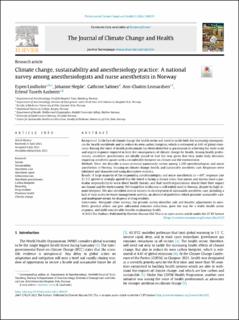| dc.contributor.author | Lindholm, Espen | |
| dc.contributor.author | Hegde, Johanne | |
| dc.contributor.author | Saltnes, Cathrine | |
| dc.contributor.author | Leonardsen, Ann-Chatrin Linqvist | |
| dc.contributor.author | Aasheim, Erlend Tuseth | |
| dc.date.accessioned | 2024-02-07T08:21:11Z | |
| dc.date.available | 2024-02-07T08:21:11Z | |
| dc.date.created | 2023-07-05T13:43:53Z | |
| dc.date.issued | 2023 | |
| dc.identifier.citation | The Journal of Climate Change and Health. 2023, 13, Artikkel 100259. | en_US |
| dc.identifier.issn | 2667-2782 | |
| dc.identifier.uri | https://hdl.handle.net/11250/3116061 | |
| dc.description.abstract | Background: In the face of climate change the health sector will need to tackle both the increasing consequen- ces for health worldwide and to reduce its own carbon footprint, which is estimated at 4.4% of global emis- sions. Raising the voice of health professionals has been identified as paramount to achieving the wide-scale and urgent response required to limit the consequences of climate change for health. Among health profes- sionals, anesthetic practitioners are ideally placed to lead the way given that they make daily decisions regarding anesthetic gasses with a considerable footprint on climate and the environment. Methods: Here, we describe a cross-sectional nationwide survey among 3,300 anesthesiologists and nurse anesthetists in Norway, focusing on climate change, health, and sustainable anesthetic care. Responses were tabulated and characterized using descriptive statistics. Results: A large majority of the responding anesthesiologists and nurse anesthetists (n = 697, response rate 21.1%) agreed or strongly agreed that the world is facing a climate crisis; that nurses and doctors have a par- ticular responsibility to warn about health threats; and that health organizations should limit their impact on climate and the environment. We found that desflurane is still widely used in Norway, despite its high cli- mate footprint. We also identified several barriers to development of sustainable anesthetic care, including a lack of easy access to waste management systems, an absence of guidelines which promote sustainable care, and inadequate means for disposal of drug residues. Conclusions: Alongside other surveys, the present survey identifies safe and feasible adjustments to anes- thetic practice which can give substantial emission reductions, pave the way for a wider health sector response, and yield considerable benefits to planetary health. | en_US |
| dc.language.iso | eng | en_US |
| dc.publisher | Elsevier | en_US |
| dc.rights | Navngivelse 4.0 Internasjonal | * |
| dc.rights.uri | http://creativecommons.org/licenses/by/4.0/deed.no | * |
| dc.subject | survey | en_US |
| dc.subject | sustainability | en_US |
| dc.subject | anesthetic care | en_US |
| dc.subject | anesthetic agent | en_US |
| dc.subject | global emission | en_US |
| dc.subject | anesthetic practitioners | en_US |
| dc.subject | carbon footprint | en_US |
| dc.subject | recycling | en_US |
| dc.subject | drug residues | en_US |
| dc.subject | planetary health | en_US |
| dc.subject | climate change | en_US |
| dc.title | Climate change, sustainability and anesthesiology practice: A national survey among anesthesiologists and nurse anesthetists in Norway | en_US |
| dc.type | Peer reviewed | en_US |
| dc.type | Journal article | en_US |
| dc.description.version | publishedVersion | en_US |
| dc.rights.holder | © 2023 The Authors. | en_US |
| dc.subject.nsi | VDP::Medisinske Fag: 700::Klinisk medisinske fag: 750::Anestesiologi: 765 | en_US |
| dc.source.volume | 13 | en_US |
| dc.source.journal | The Journal of Climate Change and Health | en_US |
| dc.identifier.doi | 10.1016/j.joclim.2023.100259 | |
| dc.identifier.cristin | 2160990 | |
| dc.source.articlenumber | 100259 | en_US |
| cristin.ispublished | true | |
| cristin.fulltext | original | |
| cristin.qualitycode | 1 | |

